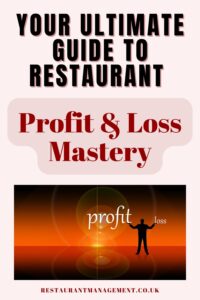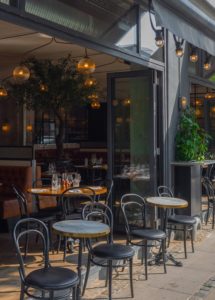First Published: 1 February 2024
Guide To Restaurant P&L Mastery
If you’ve ever thought about how your favourite restaurant manages its money or dreamt of starting your own food business, learning to read a Restaurant Profit and Loss (P&L) statement is super important! This essential skill helps in assessing how well the company is performing. While the terminology might seem complex at first, don’t worry about those tricky terms – we’re here to explain everything in a fun and easy way, just like telling a story to a fifth-grader. We will simplify these concepts to make them accessible and easy to understand for anyone, regardless of their background
Mastering Restaurant Profit & Loss Statements
Understanding and effectively managing your Profit & Loss (P&L) statements is crucial for success. Dissecting financial documents is essential to maximise profitability and make well-informed business decisions. The intricacies of reading a restaurant P&L statement empower restaurateurs like you to take control of your finances and propel your business forward.

What is a Restaurant P&L Statement?
A restaurant P&L statement, or an income statement, provides a snapshot of your establishment’s financial performance over a specific period. It outlines revenue, expenses, and, ultimately, the net profit or loss incurred by your business. Understanding the critical components of a restaurant’s profit and loss (P&L) statement is essential for accurately interpreting financial data.
Revenue Streams: Revenue streams in a restaurant’s P&L statement encompass all sources of income generated by your establishment. These may include:
Food Sales: Revenue generated from selling food items on your menu.
Beverage Sales: Income derived from the sale of beverages, including alcoholic and non-alcoholic drinks.
Catering Services: Revenue from catering events hosted by your restaurant.
Other Income: Additional sources of revenue, such as merchandise sales or rental income from banquet facilities.
Operating Expenses: Operating expenses encompass the costs incurred in running your restaurant on a day-to-day basis. These expenses may include:
Cost of Goods Sold (COGS): The direct costs of producing the food and beverages, including ingredients and packaging.
Labour Costs: Wages, salaries, benefits, and payroll taxes for restaurant staff.
Overhead Expenses: Costs related to utilities, rent, insurance, and other administrative expenses.
Marketing and Advertising: Expenditures aimed at promoting your restaurant and attracting customers.
Maintenance and Repairs: Costs associated with maintaining equipment and facilities.
Net Profit/Loss: The bottom line of a restaurant’s P&L statement reflects the net profit or loss after accounting for revenue and expenses. A positive figure indicates profitability, while a negative figure signifies a loss. Examining patterns in net profit over time can offer valuable insights into your restaurant’s financial well-being and operational effectiveness.
How to Read a Restaurant P&L
Think of a Restaurant’s P&L statement as the financial report card for a restaurant. It stands for Profit and Loss, and it’s like a snapshot of the restaurant’s economic performance over a specific period – usually a month, quarter, or year. This document reveals the amount of money the restaurant made, the amount it spent, and the profit that remains.
Start by picking a financial time period, then create a restaurant profit and loss statement. You can do this every week, every four weeks (to develop a 13-period annual report), monthly to have 12 periodic reports, quarterly to have four reports or yearly for all in one financial statement. These financial statements must be created consistently to have any effect on your business. Additionally, achieving your restaurant’s financial objectives by the end of the fiscal year is crucial, as it enables you to understand how various aspects of your business impact costs and sales.

Revenue: The Money Maker
At the top of the P&L, you’ll find the revenue section. This is where the money comes in. In simpler terms, it’s the total sales of the restaurant. If a restaurant sells burgers, pizzas, and sodas, the revenue is the combined money earned from selling these items.
Source: The primary source of revenue is obvious – the sales from the restaurant. However, some restaurants may have additional revenue streams, like catering services or merchandise sales.
Cost of Goods Sold (COGS): The Cost of Deliciousness
After revenue, the Restaurant P&L dives into the Cost of Goods Sold (COGS). Think of this as the cost of making the food. If a burger costs £5 to make, including the patty, bun, and toppings, that £5 is part of the COGS.
Source: The primary source here is the invoices from suppliers. It includes the cost of ingredients for the dishes the restaurant serves.

Related articles:
How To Improve Restaurant Profits
Restaurant Inventory Management System
Gross Profit: The First Victory
Subtracting the COGS from the revenue gives us the Gross Profit. This is critical because it tells us how much money is left after covering the direct costs of making and serving the food. A higher gross profit means the restaurant makes more money to cover its other expenses.
Source: Directly calculated from the Revenue and COGS figures.
Operating Expenses: Running the Show
Now, let’s explore the operational aspects. Operating expenses encompass the costs associated with running the restaurant, extending past just the food-related expenses. This incorporates expenditures such as rent, utilities, salaries, marketing, and other day-to-day operational costs. Consider it the entirety of spending essential to maintain the restaurant’s functionality, covering everything from keeping the lights on to ensuring the staff receives their wages.
Source: Invoices, payroll records, and other financial documents track these expenses.

Net Profit: The Bottom Line
Subtracting the operating expenses from the gross profit gives us the Net Profit. This is the bottom line – the amount of money the restaurant has left after covering all its costs. A positive net profit means the restaurant is making money, while a negative one signals trouble.
Source: Calculated by subtracting Operating Expenses from Gross Profit.
Key Performance Indicators (KPIs): The Metrics that Matter
Now that we’ve deciphered the main sections of the Restaurant P&L, let’s look at some key performance indicators, such as report card grades for a restaurant.
Food Cost Percentage: This is calculated by dividing the COGS by the total revenue and multiplying by 100. It tells us what percentage of the revenue goes into making the food. A lower percentage is generally better, meaning more money is left over. The COGS range from 28% to 40% of Sales.
Labour Cost Percentage: Calculated by dividing labour costs by total revenue and multiplying by 100, this KPI reveals the portion of income spent on staff salaries. Keeping this percentage in check ensures a healthy balance between labour costs and revenue. Cost of Labour can be as low as 18% to 23% in Fast Food restaurants and from 28% to as much as 35% in fine dining restaurants.
How To Read Restaurant Profit And Loss Statement Masterfully
How To Read A Restaurant P and L – Operating Profit Margin:
The Operating Profit Margin is determined by dividing the operating profit by the total revenue and multiplying the outcome by 100. This measurement provides insight into how effectively a restaurant manages its operational expenses. A greater margin signifies improved efficiency in handling these costs, providing an overview of the restaurant’s ability to manage its overall operating expenses effectively. Operating expenses range from 10% to 20% of sales. A critical factor is ensuring your rent is no more than 10% of sales.
Net Profit Margin: Similar to operating profit margin, it considers all expenses, not just operational ones. It’s a vital indicator of the overall financial health of the restaurant.
Putting it All Together
Understanding a restaurant’s profit and loss (P&L) statement is like piecing together a puzzle. Each component, from revenue to net profit, is crucial for gaining a complete picture of the restaurant’s financial health.
Sources: Financial statements, invoices, payroll records, and other internal financial documents are the primary sources for preparing the profit and loss (P&L) information. Industry benchmarks and financial experts provide additional context.
How To Read A Restaurant P and L – Example
Let’s break down the financials for the fast-food restaurant in the UK, making £800,000 a year in sales.
Revenue: £800,000
This is the total amount of money the restaurant brings from selling its fast-food items.
Cost of Goods Sold (COS): 30% of Sales
COS is the cost directly associated with producing the food. For this fast-food restaurant, it’s 30% of £800,000.
COS = 0.30 * £800,000 = £240,000
So, the Cost of Goods Sold is £240,000.
Gross Profit: Revenue – COS
Now, subtract the COS from the revenue to find the Gross Profit.
Gross Profit = £800,000 – £240,000 = £560,000
The Gross Profit is £560,000.
Labour Cost: 30% of Sales
Labour cost is the amount spent on staff salaries. For this restaurant, it’s 30% of £800,000.
Labour Cost = 0.30 * £800,000 = £240,000
So, the Labour Cost is £240,000.
Operating Expenses (Fixed + Variable Costs): 10% + 10% of Sales
Fixed costs remain constant, like rent, and variable costs fluctuate with sales, like utilities and marketing. For this restaurant, both combined are 20% of £800,000.
Operating Expenses = 0.20 * £800,000 = £160,000
So, the Operating Expenses are £160,000.
Net Profit: Gross Profit – Operating Expenses
Now, subtract the Operating Expenses from the Gross Profit to find the Net Profit.
Net Profit – £800,000
COGs – £240,000
Gross Profits – £560,000
Labour Cost – £240,000
Operating Expenses – 160,000
Net Profit = £160,000 (Before Taxes)

Conclusion – How To Read A Restaurant P and L
How to Read a Restaurant P&L may seem daunting initially, but breaking it down into bite-sized pieces reveals a simple story of income, costs, and profit; just like how a chef combines ingredients to create a delicious dish, a restaurant manager uses the P&L to blend various financial elements into a recipe for success.
Aspiring restaurateurs and food enthusiasts can benefit from demystifying the financial side of the culinary world. By understanding the language of numbers, you can appreciate the financial intricacies that make your favourite restaurant a haven for good food and a thriving business.
Frequently Asked Questions And Answers
How do you read a profit and loss statement for a restaurant?
Start by examining the revenue section at the top, representing the restaurant’s total sales.
Calculate the Cost of Goods Sold (COGS)
Subtract the COGS from the revenue to obtain the Gross Profit, indicating how much money is left after covering food costs; this will give you the direct costs associated with producing the food.
Analyse the Operating Expenses, which include rent, utilities, salaries, marketing, and other day-to-day costs.
Subtracting the Operating Expenses from the Gross Profit reveals the Net Profit, providing insight into the restaurant’s overall profitability.
How do you analyse a P&L statement?
Review the revenue section to grasp the total sales.
Find the Gross Profit by removing the cost of making the stuff (COGS) from the money that came in.
Analyse Operating Expenses to comprehend the day-to-day operational costs.
Assess the Net Profit by subtracting Operating Expenses from Gross Profit.
Look at key performance indicators like profit margins and ratios to gain deeper insights into the financial performance.
What is a good net profit margin for a restaurant?
An excellent net profit margin for a restaurant typically ranges from 3% to 6%. However, this can vary based on the restaurant’s size, location, and type of cuisine.
High-end restaurants may have higher net profit margins, while quick-service establishments might have lower margins, ranging from 0% to 15% or even 20% per annum.
It’s essential to consider industry benchmarks and the restaurant’s specific circumstances when evaluating the adequacy of the net profit margin. If we have wet your appetite for more profit, find out how to increase your restaurant profit here!
How to Improve Restaurant Profits and Increase Restaurant Sales


